Oregon Wine Production
Oregon is renowned for its high-quality wines, especially Pinot Noir, and has emerged as one of the premier wine regions in the United States.
Oregon has a cooler climate than California. The climate, much like like Burgundy in France, makes it perfect for producing "cold climate" wines like Pinot Noir, Pinot Gris, Chardonnay, and Riesling.
18,000 Hectares
(44,500 Acres)
45 million Litres
800+ Vineries
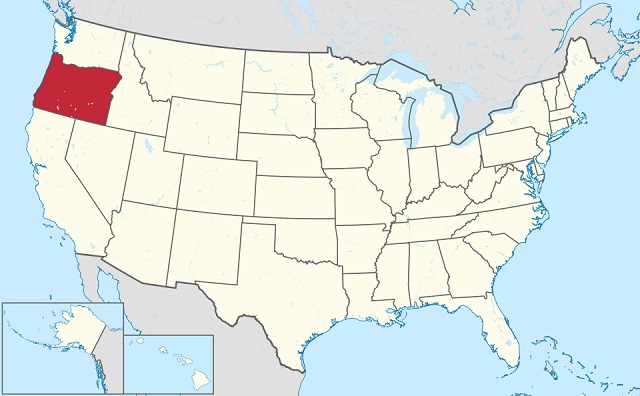
Oregon wine production accounts for about 1% of U.S. wine output but garners high acclaim for its quality. Exports have grown significantly, especially to markets in Europe and Asia. The focus on sustainability and terroir-driven wines sets Oregon apart as a leader in premium winemaking.
Oregon is a leader in sustainable viticulture, with many vineyards certified organic, biodynamic, or LIVE-certified (Low Input Viticulture and Enology).
Most Oregon wineries are small and family-owned, focusing on artisanal wines and high-quality production.
The premier region is the Willamette Valley, which worldwide reputation Pinot Noir wines.
Primary Red Grapes:
- Pinot Noir (prominent)
- Cabernet Sauvignon
- Syrah
Primary White Grapes:
- Pinot Gris (prominent)
- Chardonnay
- Riesling
- Sauvignon Blanc
Oregon Grape Statistics
Oregon's vineyards span approximately 44,500 acres, with the following grape distribution:
| Grape | Acres |
|---|---|
| Pinot Noir | 27,000 |
| Pinot Gris | 6,000 |
| Chardonnay | 3,000 |
| Cabernet Sauvignon | 1,600 |
| Syrah | 1,800 |
| Merlot | 825 |
| Riesling | 525 |
| Viognier | 425 |
| Cabernet Franc | 400 |
| Tempranillo | 400 |
| Malbec | 300 |
| Pinot Blanc | 300 |
Source: University of Oregon 2022.
Climate and Geography
The cool-climate conditions, especially in the Willamette Valley, are ideal for Pinot Noir.
Warmer regions, such as the Rogue Valley in Southern Oregon, support Bordeaux-style varietals and Syrah. Proximity to the Pacific Ocean provides cooling effects, ensuring long growing seasons and balanced grape ripening.
Oregon Viticultural Areas (AVAs)
Oregon boasts 23 federally recognized AVAs, each with unique microclimates and soil types.
The most famous are listed below:
| Region | Acres | Ha |
|---|---|---|
| North Wilamette Valley | 24,500 | 9,900 |
| South Wilamette Valley | 4,600 | 1,900 |
| Rouge Valley | 6,000 | 2,400 |
| Umpqua Valley | 3,900 | 1,600 |
| Walla Walla Valley | 2,900 | 1,200 |
| Columbia Gorge | 2,200 | 890 |
Source: University of Oregon 2022.
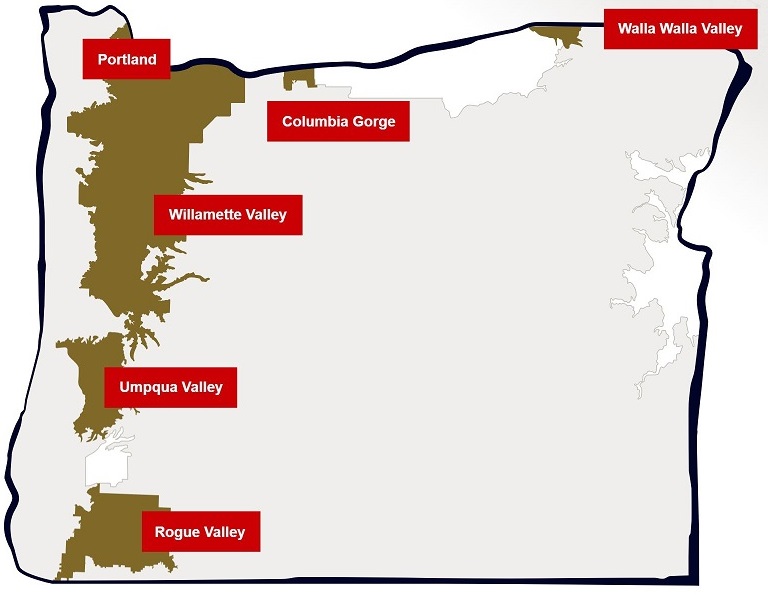
Willamette Valley
Willamette Valley AVA (Est 1983) is Oregon’s largest and most famous AVA, covering about 70% of the state’s vineyards and world-renowned for its Pinot Noir.
Sub-AVAs within Willamette Valley:
- Chehalem Mountains
- Dundee Hills
- Eola-Amity Hills
- McMinnville
- Ribbon Ridge
- Yamhill-Carlton
- Van Duzer Corridor
Southern Oregon AVA
Southern Oregon AVA (Est) includes Umpqua Valley and Rogue Valley. It produces a diverse range of varietals due to warmer temperatures.
Top varieties:
- Syrah
- Merlot
- Tempranillo
Columbia Gorge
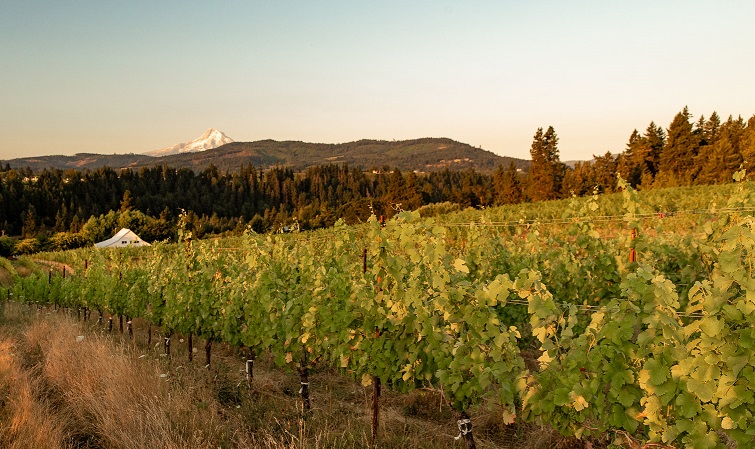
Hiyu Wine Farm. www.oregonwine.org
Columbia Gorge AVA (Est 2004) straddles Oregon and Washington along the Columbia River. The region produces aromatic whites like Riesling and Gewürztraminer, as well as Pinot Noir.
The climate is transitional. The west, close to the Cascade Mountains, has a cooler, marine-influenced climate where it rains 36 inches per year. 40 miles east, the climate transitions to continental high desert with just 10 inches of annual rainfall.
Throughout the Gorge, elevations of vineyard sites range from sea level to 2,000 feet, which greatly impacts temperatures during the growing season.
Walla Walla Valley
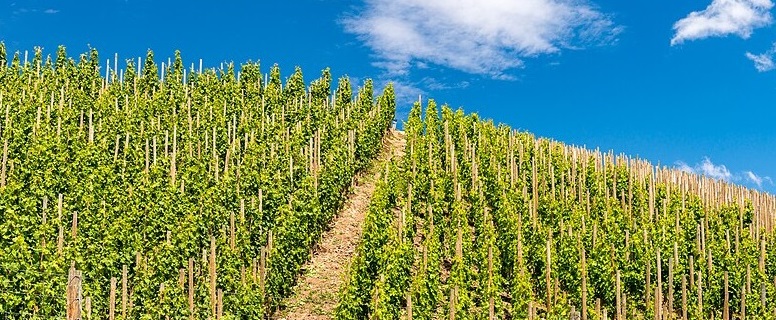
Walla Walla Valley AVA is shared with Washington State.
A warm growing season, low rainfall, and complex soils lead to layered, full-bodied wines.
Hot July and August provides a vibrant ripeness in the berries, and cold September nights assures the acidic backbone for superb wines.
Primary grapes:
- Cabernet Sauvignon
- Syrah
- Merlot
Predominant Soils: Volcanic, Missoula flood sediments, loess, cobbles.
Rocks District of Milton-Freewater
Rocks District of Milton-Freewater (AVA in 2015) is a small, distinctive AVA within Walla Walla Valley, notable for its Syrah grown in rocky soils.

The Rocks District signature cobblestones.
Rouge Valley
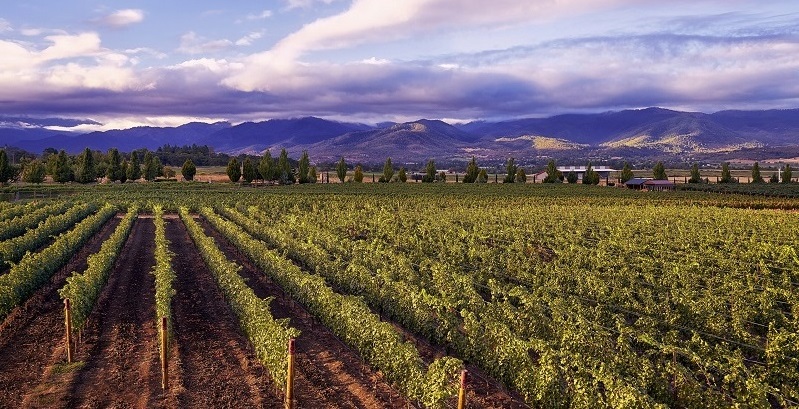
Photo credit: Marc Salvatore. www.oregonwine.org
Primary grapes:
- Cabernet Sauvignon
- Syrah
- Viognier
- Pinot Noir
- Chardonnay
- Pinot Gris
Predominant Soils: Stream sediments.
The Umpqua Valley
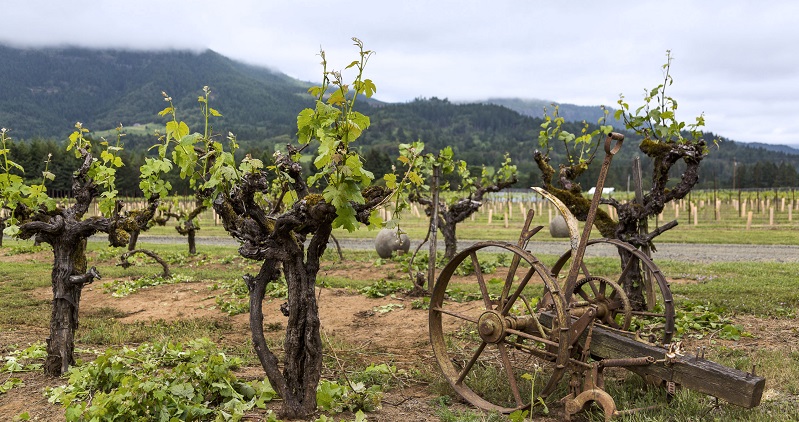
Hillcrest Vineyard. www.oregonwine.org
The Umpqua Valley AVA (Est) sits between the Coast Range to the west, the Cascade Range to the east, the Willamette Valley to the north, and the Rogue Valley to the south.
The region's winegrowing history dates back to 1880 when German immigrants planted the first vineyard in the Valley. In 1961, Richard Sommer established HillCrest Vineyard near Roseburg and sunk Oregon’s first Pinot noir vines into the ground. Like his Willamette Valley peers, he ignored the pessimists in California who said Oregon was too cold and wet to grow Pinot. In fact, the Umpqua Valley has one of Oregon’s more diverse regional climates, successfully growing both cool and warm varieties.
Snake River Valley
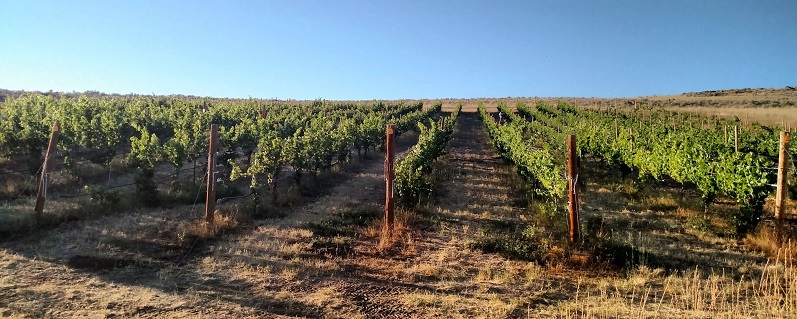
Snake River Valley (AVA in 2007) spans from eastern Oregon into Idaho. The region is populated with few wineries in Oregon but features the largest density of wineries in Idaho.
The high mountain desert environment, more than 400 miles (645 km) from the tempering effects of the Pacific Ocean, is known for producing wonderful Syrah, Viognier, Riesling and Chardonnay wines.
At elevations of 750-915 meters (2,500-3,000 feet), the region has a diurnal temperature variation of 20°C (35°F). The cold nights and warm days during the summer serves to balance grape acids and sugars favorably.